In the third and final part of Tom Venuto’s interview about his trek on the Pacific Crest Trail, he talks about what mistakes he made on his hike, post trail depression, did he form bad eating habits, how to transition back into normal eating, does metabolism change after a thru-hike, is muscle memory working after returning to full-time lifting, and much more… [go back to part 2 | part 1]
In the fitness world, you are a respected expert, but in the world of through-hiking, though, you were a newbie. Was that at all humbling, or did you find it to be a difficult transition?
Yeah, everything is hard at first, because you don’t know how to do it yet, but you just have to remind yourself that you can learn. You can learn anything. But you can’t quit just because the learning curve is hard. The learning curve is always hard and that’s why so many people quit very early on in all kind of endeavors.
At the time I set the goal to hike the PCT, I’d done a lot of day hiking – even to the top of Mount Whitney from the portal and to the bottom of the Grand Canyon and back to the rim – so I had done some pretty intense day hikes, but I had never backpacked a day in my life. I didn’t even know how to pitch a tent. I had zero experience in snow, let alone mountaineering – I didn’t know what crampons were. I had never filtered water let alone forded a creek. I didn’t know how to navigate or use a compass.
I was completely green – I was the least likely person to ever start a thru hike. Everything about backpacking was way out of my comfort zone. But I had this goal, I had this dream, this bucket list item – I wanted to hike the PCT – and I wanted a growth challenge, so decided to learn.
I found out that all the help and all information I needed about gear and logistics was literally a click away on social media and Internet forums, and there were plenty of books on the subject, and all the maps I downloaded on my iphone with GPS, so there was a learning curve, but it wasn’t that hard –
I’m sure people who hiked the PCT in the 70’s and 80’s and 90’s had it a lot harder, in fact I sometimes wondered how they did it.
There are some things about thru-hiking the PCT you can only learn on the PCT, and sometimes you learn in a painful and humbling way, but I was as prepared as I could be before the hike and I learned everything else really fast.
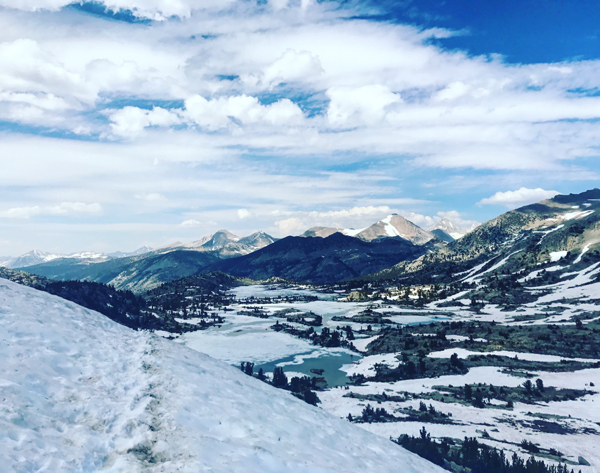
When you have to hike through this terrain every day, you learn fast! (about crampons, ice axe, navigation, weather, shelter, staying warm and a lot more!)
So just keeping that learning mindset, and I know you’re always studying and reading so it was probably just normal for you to do that. With all the solitary time you had on trail to think, did you have any epiphanies?
You do have a lot of time to think and it’s interesting to watch how your mind works and what kind of thoughts pop in your head when you’re out there so long. I think walking can stimulate your subconscious mind and I had all kinds of creative ideas popping up. I seriously think I wrote a few books in my head while I was on the trail and it wasn’t from working at it or thinking hard, it all just bubbled up and I feel like all I have to do now is sit down and empty my head onto paper.
So yeah, I did a lot of thinking, but I also did a lot of not thinking, just being quiet, and being in the moment and in the experience. So if there was an epiphany I guess it was about mindfulness and the effect that being mindful has on your experience and on how happy you feel and how much you enjoy it.
I’m sure one thing that made the PCT so amazing was I was really in every moment, opening all my senses, really paying attention and seeing everything around me and trying to have an uncluttered mind. I didn’t even play music because I wanted to hear the sounds – or no sounds, just pure silence.
When I wasn’t doing that, when I wasn’t being present, I know I wasn’t having as much fun, I’m sure I was missing a lot, and I even had a few times I was feeling anxiety because I was distracted or thinking about stuff back home or thinking about the future.
If I was worried about whether I’d be able to squat even 200 pounds when I got to the gym when the hike was over, or whether I was losing too much weight, or if it was bothering me that I could only get online once a week to catch up on business, or if I was focused on anything but the trail, it didn’t feel peaceful and I didn’t enjoy it as much.
Speaking of music, I remember that there were some points on the trail where it would have been dangerous to have music on
That’s possibly true. They do warn you to watch out for rattlesnakes in the desert, and there are even some spots up north on the trail there are rattlers. I almost stepped on a rattlesnake twice, so you have to really be aware of your surroundings and if music is blaring in your ears, you won’t hear it if a rattler gives you warning.
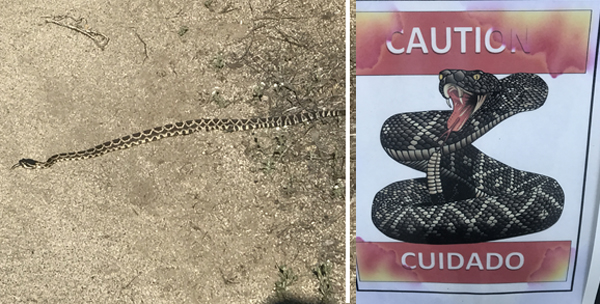
You have to watch your step on the Pacific Crest Trail
Hindsight is 20/20. Looking back, can you pinpoint any major errors you made and if so what were they, and what did you learn from them?
The only thing I can think of is that I would have started earlier. I started May 22nd – and most thru hikers start in April or early May. Occasionally someone starts in late March if it’s a low snow year, but usually if you start that early, you won’t make it through the snow when you get to the Sierra mountains.
It was an informed decision. My decision was because of the record snowpack in the Sierra in 2017. People who got there too early couldn’t get through the snow and they would skip up to Northern California or Oregon and they’d come back to do the Sierra in September. So starting late made sense to give time for the snow to melt more.
But I couldn’t foresee all the fires. Everyone I talked to had to contend with at least one or two fires, because at least one or two started early in the season. But some people, because of their timing, they beat all those late season fires I ran into – it’s like they threaded the needle and snuck through just in time, whereas for me the fires kept popping up in front of me.
I did make it through the Sierra and there was still a ton of snow even in the 2nd and 3rd week of July, but it was passable and also beautiful with all that white on the mountains. But there was no way for me to know what would happen in Oregon and Washington so maybe it wasn’t an error, maybe it was bad luck, bad timing.
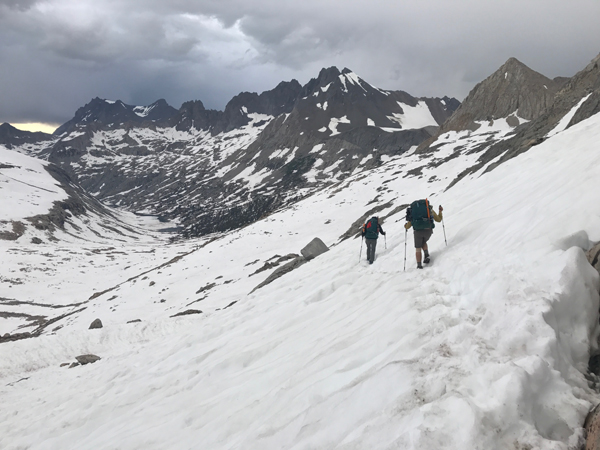
Getting through the Sierra Nevada Mountains in 2017 was more like mountaineering than hiking
Either way, if I could do it over again, I still would have started at least two weeks earlier. I might have had to go through more snow in the Sierra, maybe I’d have to do the flip flop like other people, flip past the Sierra and come back and do it later. But I would have felt less rushed. I wouldn’t have to push 26 to 30 mile days, and that was really hard on the body.
When I was pushing those 26 to 30 mile days that’s when I really started dropping weight again and it was just exhausting. I also think I might have missed some of those fires that broke out late in the season if I started earlier. If I could do it again and it was a regular snow year, I would start in April.
Is it normal to start at Mexico and go north, do most people do that?
Yeah, the vast majority start at the border of Mexico, it’s in the San Diego back country near a little town called Campo, that’s where the Southern terminus and border monument is. But a handful of people hike Southbound. They start at the Canadian border and go through Washington, Oregon and California in that order.
And there’s sometimes as much or more snow in those Northern Washington Mountains as there is in the Sierra, so they can’t start in March or April or May, they can’t even start in June because it’s not melted out in June. So usually a Southbound hiker will start in July, and they’ll hike longer and end up finishing in November or maybe late October.
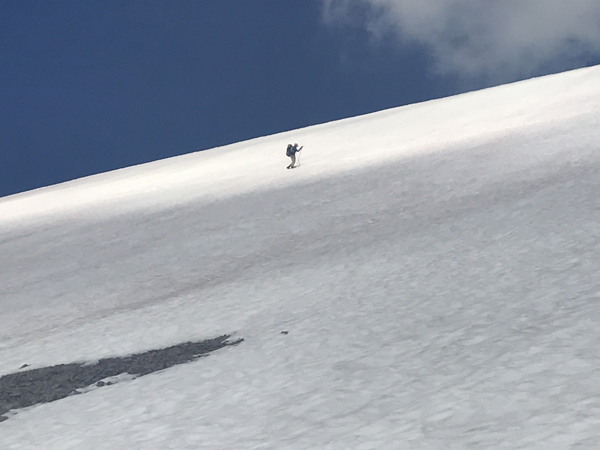
2017 was a high snow year on the Pacific Crest Trail… It didn’t matter whether you started in Mexico and hiked North, or started in Canada and hiked South… there was no escaping the white stuff
So it’s just a logistics question of where the snow is
Yeah, everybody sits there and follows the weather all winter, because you don’t know what kind of snow year it will be until it you’re well into the winter. It’s interesting that the permit system changed and they’ve now started issuing permits on November 1st, and people pick their start date and April fills up first because April is the most popular month to start.
But at that time, before the winter, no one knows what the conditions will be like, so if someone picks an really early start date like April 1st or April 7th and it’s another high snow year, they’re not going to be able to make it through the Sierra, or else it’s going to be very very challenging.
So when you got your permit, did you have to say when you were going to start or was it for the whole summer?
You pick a start date. And most people are pretty good about sticking to their permit start date. There were some interesting debates on the facebook group with some people saying just start whenever you want, but it’s the right thing to do to pick a date and stick to the date on your permit
Did they ever check your permits?
Well that’s another funny story. I had my permit checked once and it was so I could get the free slice of Pie at Mom’s pie shop in Julian California because they have free pie for PCT hikers, but you have to prove that you’re a PCT thru hiker.
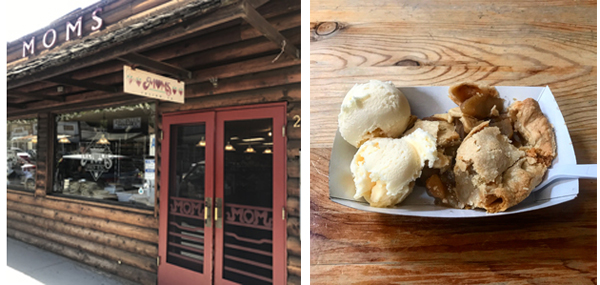
A ranger might ask for your hiking permit…but the only time I was asked for my permit was at Moms Pies
So you can’t go into the pie place and say look at me, I’m wearing a backpack and I smell bad, and they don’t just trust you?
Nope, no permit no pie.
I remember when you announced your plans to hike the Pacific Crest Trail, a lot of people criticized you pretty harshly, they said you’d lose all your muscle and that you were insane for undertaking this endeavor. How did you answer them then? And what do you have to say to them now?
Yeah, I did get criticized. I’m not sure whether it was harsh and serious or just kidding around, like a lot of my friends from the gym were busting my chops and saying, you’re gonna lose your gains, you’re gonna lose your gains! If it was 20 years ago when I was a full-time competitive bodybuilder, I might have criticized the idea myself, or maybe not criticized – but I would never even consider long distance hiking because it’s antagonistic to bodybuilding.
But I think a lot of people who announce their hike get criticism at first purely because it’s a massive goal so big, it’s hard to even wrap your head around. Honestly, it is kind of insane, so it’s human nature to start hearing things like, “It’s impossible, you’re going to get yourself killed, no one is making it through the Sierra this year, you’re not experienced enough, how can you afford to take months off work, how can you just up and leave everyone behind,” and the list of goes on and on.
I didn’t get that kind of criticism – for me it was mainly that people in my field saw me wanting to try something that was totally conflicting with my other goals – bodybuilding and strength training – and conflicting with the whole culture in our sport.
Thru-hiking can get you extremely fit, but it’s the opposite kind of fitness – it’s endurance. So the reactions to thru-hiking were similar to any time I ever mentioned jogging or running, some of my lifting friends and colleagues started laughing.
How did I answer? I didn’t answer verbally. I answered by going out and doing it anyway. And granted, they weren’t entirely wrong – I did lose some muscle, I did lose a good amount of strength and a lot of it in my legs.
But I was also the only person I know of who kept lifting weights during a thru-hike. I’ve never heard of anyone ever, on any long distance trail, who kept lifting on a thru hike because it almost doesn’t make sense to try. But I was able to keep a 34-year lifting streak going and I maintained more lean mass than most people do, especially in my upper body.
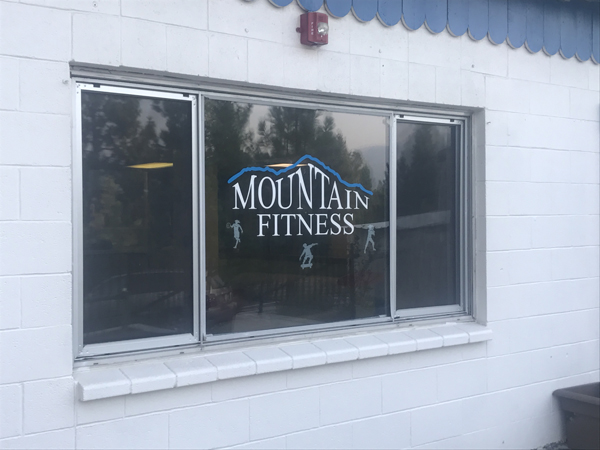
Mountain Fitness, Mount Shasta California. To the best of my knowledge, I am the only person to ever lift every week while thru-hiking the PCT
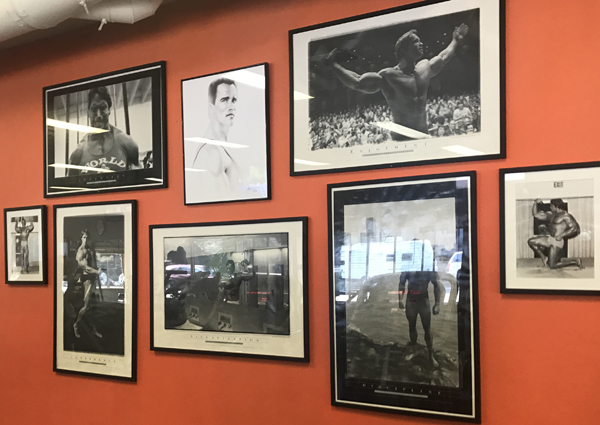
The “Arnold Shrine” at the Body Shop Gym, Mammoth Lakes. California, Elevation 7,880 feet…
Well it seems like most people would not have the energy to even try to lift
That’s exactly true. There were days I didn’t want to lift. Not to mention, on multiple occasions I had to get a cab or uber 20-35 miles to a town that even had a gym.
And I didn’t do that much lower body training – you just don’t have the physical capacity, especially the same day. Like even if it’s only 20 miles a day, forget 25 or 30, and you get into town and even after you get a good meal and you rehydrate, to go to the gym late in the day, it’s ridiculously hard.
But if I stayed overnight in a town, then the next morning it’s amazing how much you recover overnight. I was always amazed how much I recovered overnight. My feet, I could barely walk at the end of some days but the next morning, as long as that plantar fasciitis wasn’t bothering me my feet felt fresh the next morning.
And with lifting, with one overnight rest, after a couple good meals, then I could go in the gym the next morning and that’s how I kept it up.
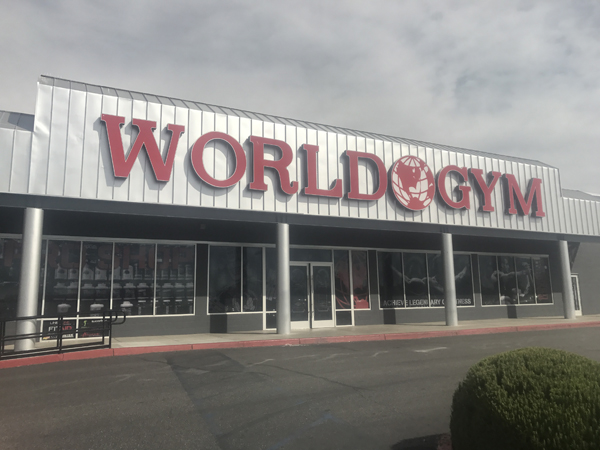
I took an uber 34 miles out of Wrightwood to Victorville just so I could keep up my lifting routine
That’s amazing because for most people, a 20 mile hike would wipe them out for a couple of days, but you were doing that day after day after day and then lifting. To what would attribute having that kind of energy to do that – just years of healthy living?
It was really really hard, I was just so committed to lifting. I made a commitment. I made a commitment that I would keep lifting. And having such a long lifetime streak of lifting, I’ve never taken more than two weeks off lifting in my life, for 34 years straight, and I really wanted to keep that record intact, so I ended up lifting once or twice a week, basically when I had access to a gym in town.
I did find out that doing upper body was hard, my whole body was exhausted in general, but my upper body didn’t take the hit my lower body did. The hardest thing was to keep up the leg training. But how did I do it? Mainly it was making the commitment before I even started the trail, and even though no one had ever done it before, and everyone said it was impossible, I told myself I’ll be the first.
And you were flexible too as far as what you did and realized that if you can’t do much lower body it’s not the end of the world?
Yeah, I did really simple lower body workouts. No lunges or split squats because they cause unbelievable muscle soreness so they were out completely. The last time I squatted was about mile 450, when I got off at Santa Clarita and trained at Golds Gym and I got really bad muscle soreness, and
I was worried about injury so that was the last time I tried to squat. So I just did some leg extensions, leg curls and leg press, and I didn’t push it really hard or really heavy – never close to failure. I did push hard on upper body training and I think it paid off.
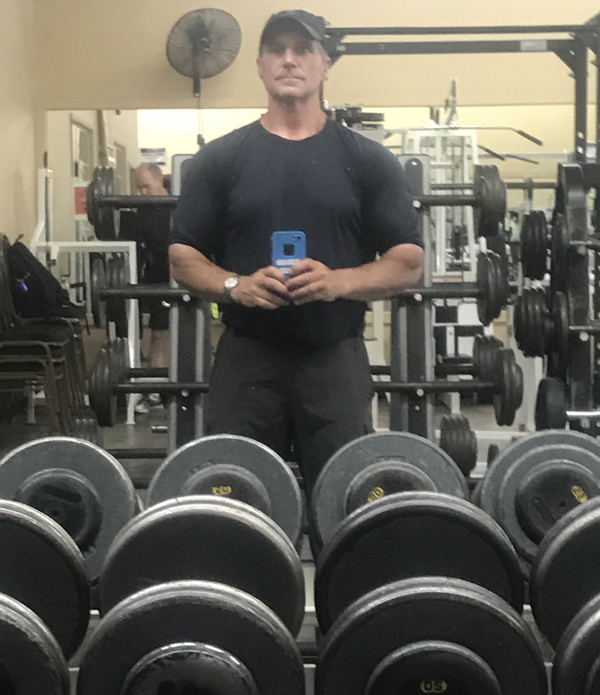
Training at Valley Fitness in Lake Isabella California – Mile 650 on the Pacific Crest Trail – I was still holding on to my upper body size and strength… but it got a lot harder after entering the Sierra
You didn’t look that different in your photos, and I was comparing, I was trying to look at the beginning and the end because I knew it was such a worry for you and you did not look that different in your photos.
About 10 to 12 pound difference in body weight, that’s it.
Yeah that’s amazing. Well now that you’ve been home for several weeks, as far as nutrition goes did you pick up any bad habits you now have to break and was it difficult to get back into your body building style nutrition
Well it is true I have to admit that I ate more junk food in 4 months on the trail than I’ve eaten in the last 4 years – maybe in the last 14 years. But I still ate the majority of my calories on the trail from healthy foods like whole grains, oatmeal, rice, tuna, whey protein, nuts, peanut butter and dried fruits.
Eating the rest of those calories from junk or energy bars, was a necessary evil or I would have lost an unhealthy amount of weight, plus you can’t carry perishable foods on the trail.
I did do some things you would never normally see me do. If I was offered a soda in the desert by a trail angel, of course, I took it. I would take two! You can’t imagine how good an ice-cold soda tastes after 15 miles in 95 degree sun until you’ve been there. And ice cream – nothing beats ice cream in the desert.
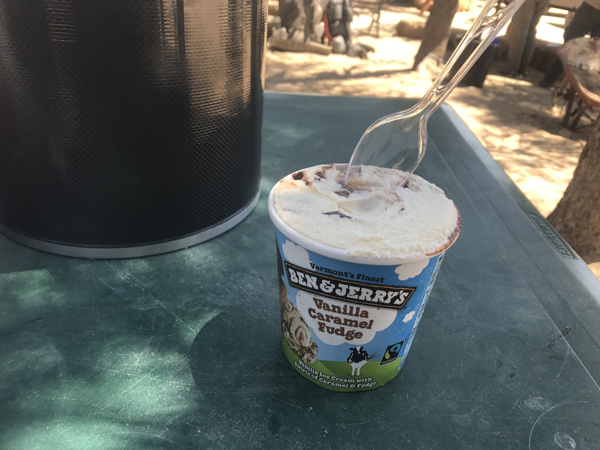
A little snack at Kennedy Meadows… (1100- calorie dessert… after the cheeseburger and fries…)
I had a few Snickers. I had Pop Tarts in one of my resupplies for a whole 4 or 5 day stretch because a backcountry food store had no oatmeal but lots of Pop Tarts on the shelf. Pop tarts are another hiker staple. I don’t even really like Pop Tarts, but they got me some calories I needed in a pinch.
When I got in town I gorged myself on pancakes with cheese omelets, pizza – I could eat a whole pizza easy – Italian, like spaghetti with meatballs, lasagna or baked ziti, Mexican, cheeseburgers. There were microbreweries in so many trail towns near the mountains I had to sample those.
I would go to nice restaurants and celebrate milestones with all kinds of gourmet meals and get dessert too – cheesecake, pie, chocolate decadence cake – you name it. I was drinking Gatorade all the time, though I never used to drink Gatorade. I’d drink it until my stomach was full.
No matter what I ate or drank though, I kept losing weight – you burn so many calories, it’s almost impossible to eat in excess on the trail, and you can’t put all of the lost weight back during short stops in town, even though I came close sometimes and managed to keep myself from losing too much.
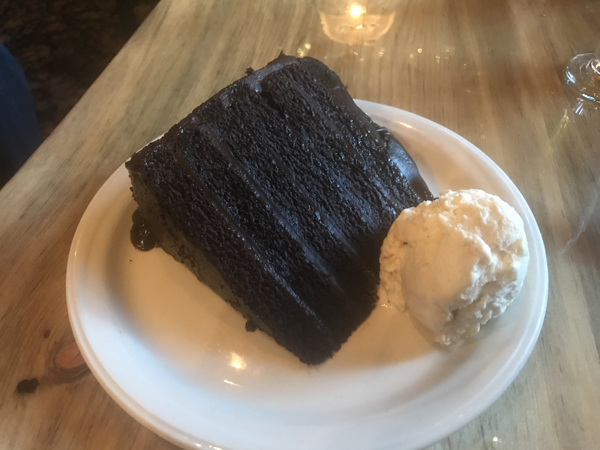
Desert was always a must… or else I would fall short on my town calorie surplus…
But to answer your question, no, none of this became a bad habit. I already have really deep-rooted habits, good ones, and they came from 30 years of following a bodybuilding lifestyle. So four months of a trail lifestyle doesn’t undo 30 years of a bodybuilding lifestyle. I haven’t even thought about having another Coke, it’s just not something I do. I’ve never been a big ice cream eater and after I got out of the desert, I haven’t had any since.
Actually I have fewer cravings or desires for junk food than I’ve ever had because by the end of the hike I was getting sick of force-feeding myself, I was sick of junk food and I started getting cravings for fresh food. Toward the end of the hike, I would go into town for resupply and while I was there I’d fill up with fruit and I would make sure I would get a salad no matter what else I was eating.
The big problem for most people is they get used to eating 4000 to 6000 calories a day and when they get home they keep eating too much and their activity level plummets, so they rebound and get fat. It was the opposite for me. It was a relief to stop eating so much. And it was a relief getting back to my usual foods when I got home.
So there aren’t any foods that you miss because they don’t fit into your nutrition plan now?
No, I just slipped right back into the way I’ve always eaten for the last 30 years – bodybuilding nutrition. I do believe in flexible dieting, but I’m also what you might call a really clean eater because 90 to 95% of my weekly calories are unprocessed, nutrient-dense healthy foods, but the other 5 to 10% of the time I have whatever I want and I don’t even think twice about it – no guilt.
I just haven’t been getting the cravings for it. A month after being back I had two slices of pizza once and one burger, but that’s it. That’s probably even less cheat meals than I used to do in a month.
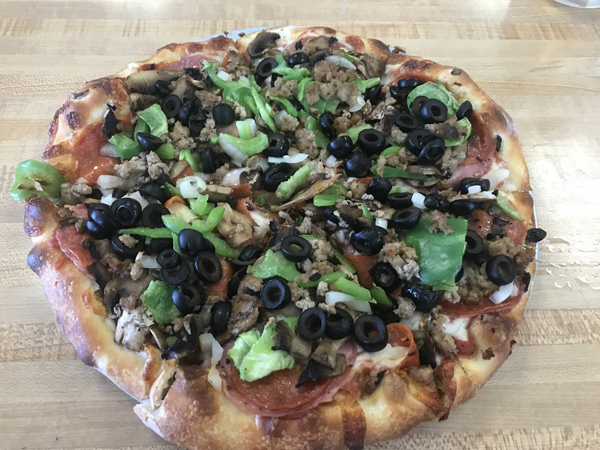
On the trail, I could kill a whole pizza in one sitting … still kept losing weight
What about hunger levels and metabolism? Would you say your body is in a state of rapid fat-burning, as a result of your lifestyle over the last 4 months?
I don’t think I have an elevated metabolism or that I had one when I got back or that 4 months of hiking puts you in some kind of fat-burning mode. Fat-burning is a matter of calories in versus calories out in real time – your metabolism doesn’t get amped up from a thru-hike, unless by metabolism you’re talking about the unbelievable amount of calories you burn on the trail. Then when you’re back to normal life, your metabolism or rate of calorie-burning goes back to normal.
But in my case, I don’t think my appetite is back to normal, and I think I’m the opposite of what most people experience – I’ve had a hard time eating enough and my body weight is still only in the upper 170s because I’m not that hungry – I think I got sick of eating. It’s not bad though because I’m leaner than I’ve been in years and at this point in my life I think I’m done with bulking – I’d rather stay on the leaner side from now on.
So you said you’re weight has stayed about the same since you’ve been back, how about your lean body mass, how has that changed?
I haven’t done a body fat test, to be honest, I’m only tracking body weight and how I look. Visually, I look like I’ve gained almost all my muscle back in my upper body. Maybe I’m a little bit of a smaller version of how I used to look, but the muscularity looks as good as it’s been, it’s just not quite as much mass. My weight has fluctuated between 177 and 179. That’s a light body weight for me to maintain.
Just to give some perspective, when I used to compete, in the off season I would go up to 190 at least, and sometimes 195, and I wanted to make the middleweight division and the cutoff is 176 and that was the heaviest I ever weighed for a competition, sometimes I competed even lighter, closer to 170. But I would never be able to hold that weight because that was really dieted down and maybe even a little dehydrated.
Sometimes the day after a show where I weighed 176, I’d be back up to 182 the next day and then within a week up to about 185, and then I’d stabilize there and sometimes slowly grow up to 190-195. So I’m holding a pretty low body weight right now but I appreciate being leaner now than I used to be – I think I used to be a little too far to the bulky side.
Do you see yourself staying around that same weight?
I would like to get back up to the mid 180s but stay lean. You could call it a body recomposition goal or pure lean gaining goal – put on some more muscle but stay lean.

Northern California sunrise near the Trinity Alps Wilderness… By this point I was covering 25 to 30 miles a day and it was tough to keep the weight on
And how is that muscle memory working
It’s working great. Muscle memory is a real thing. Exercise physiologists have done a lot of new studies on this and it’s pretty interesting stuff since they’ve learned the mechanisms of how it works, so muscle memory is not a myth.
It’s absolutely true that if you quit lifting for any reason and you lose a lot of muscle, or if you do something like train to run a marathon or do a thru hike and you lose some muscle because of that, when you go back to full time lifting again, and you pull back on endurance training you’re going to gain back the muscle a lot faster than it took you to build it in the first place. It can be a lot faster – it might even be 10 times faster.
I remember reading one story where the subjects gained back in six weeks what it took them six months to build in the first place, so it comes back pretty quick.
For me it’s been about four weeks to get closer to normal in the upper body. Lower body is going to take a bit longer, maybe six weeks, eight weeks or ten weeks, but I’ll get there, I just have to keep training.
Earlier you were talking about post sierra depression, and I’ve read about post-trail depression. Have you experienced this?
Maybe I’m experiencing something psychological, but I don’t think I’d call it depression. I’ve had feelings of missing the trail, and reminiscing, and I definitely have wanderlust that’s not going away and I want another adventure, but at the same time there are those mixed feelings I have about the effect long distance hiking has on the body.
I think what most thru hikers do to avoid the depression is they set a goal for another hike and start planning, because the excitement and anticipation for a massive goal, it can last months before a hike – it did for me. I started planning around August in 2016 for a May 2017 hike and I was excited for all those months in between, it was the only thing I could think about. So when people set their sights on another hike or any big goal, there’s no time for depression because you’re busy getting amped up to do it again.
But if you don’t have another goal of some kind, you do get left with this void, feeling empty. I haven’t set a goal for another thru-hike yet, but I’ve set different goals for my training in the gym and also a lot of business goals and writing new book goals, and that’s having the same effect – I’m excited about all my new projects. If I was retired, sitting around doing nothing, I’m pretty sure I would feel depressed right now.
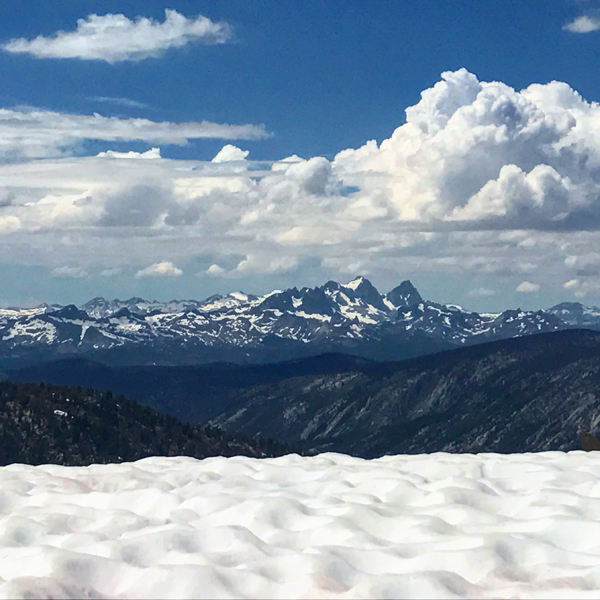
I already miss the Sierra… but I’ll be back
So if you are looking for a bigger adventure than the PCT, what would be a bigger adventure bigger than that?
There aren’t many adventures bigger than the PCT. I know some people who sailed around the world, but that’s not on my list. I read an interesting statistic that more people have summited Mount Everest than finished the whole PCT in one season. So if we say bigger adventure meaning more miles, higher mountains, or more time required, no that’s not what I’m looking for.
I’m thinking more in terms of finding something new or different than I’ve ever done before. That could be something I could do in a day, but is out of my comfort zone and gives me a totally new experience – that’s where I want to go.
I have a long list of ideas but I have plenty of time to narrow it down and decide what’s next – for now I have those training and book writing and business goals I’m focusing on more than what mountain I’m going to climb next.
So do you feel compelled to go back and finish the section that you missed?
Yeah there’s about a 99% chance I’m going to go back and finish the trail. That will probably take about 5 weeks and that’s a pretty good adventure right there. I was really fortunate that I got to see the best parts of the trail – I got to see the Sierra, I got to see the North Cascades and the Glacier Peak Wilderness.
The only thing I really wanted to see that I missed was there’s a section in Washington that’s called the Goat Rocks Wilderness which is spectacular because you’re walking on a knife’s edge, it’s an epic ridge walk and you can see Mount Rainer, and one volcano after another on a clear day. I was hoping to get to see that, but at least it gives me something to look forward to next time.
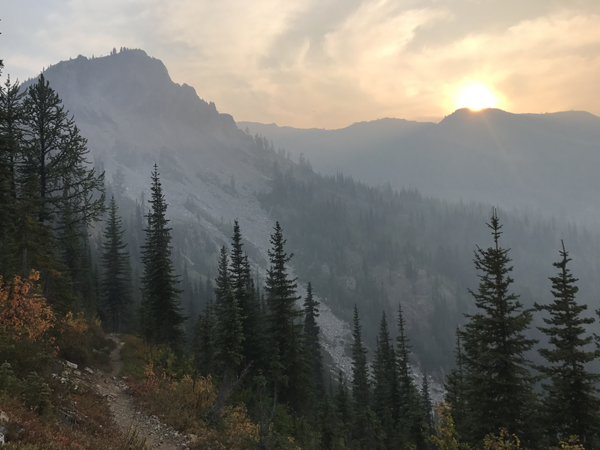
Washington was spectacular, second only to the Sierra, and I plan to go back and hike the rest of it
What’s ahead for you personally and professionally?
Well the big 50 is coming up next year and for milestone birthdays most people don’t need any nudges, they want to do something big and I feel the same. But it may or may not be another big outdoor or travel adventure, I also have a lot of professional projects ahead.
Since I’ve been home from the trail, I’m writing every day again, and the one project I’m most personally excited about is flipping me back from endurance training to building muscle. Most of the books I’ve written in the past are about fat loss, but really my background and my original passion for the fitness industry has been is natural bodybuilding, and I have a lot to say on this topic and I want to get it down on paper and into new programs so I can share with a lot more people, so I’m doing a series on building muscle.
Initially I planned on it being a trilogy. One of them is already done and it’s called The Ultimate Progressive Overload Training Manual and to the best of my knowledge it’s the only book that teaches the progressive overload principle in depth, and that is the real ultimate secret to gaining muscle.
And there were two more manuals in the works – the Ultimate high intensity training tactics manual and the ultimate systems and strategies manual, but now I’ve added another– the ultimate muscle-building exercise guide – so this is a four-part series of training manuals I’m working on and they’re all coming along nicely – I’ve been really focused since I got back to the office. And like I mentioned before, I feel like I’ve already created the programs and wrote the books in my head and now it’s just a matter of emptying what’s in my head onto paper. It’s great.
There’s been a ton of new great content that you’ve added to the Inner Circle and it sounds like there’s even more great stuff to look forward to.
Yeah, I’ve been busy and it’s going to be a busy year and a lot of great stuff is going to happen in our fitness community in the year ahead.
If people want to learn more about you or find you online, how can they do that?
The public website that everyone can visit and read every week is right here – the Burn the Fat Blog. You can also follow at facebook.com/burnthefat and we now have over 150,000 fans there. And of course our members only community is burnthefatinnercircle.com and it’s the best fitness support community you could ever be a part of. My print books are available on Amazon dot com and my ebooks and training manuals you can find at the BurnTheFatInnerCircle.com site

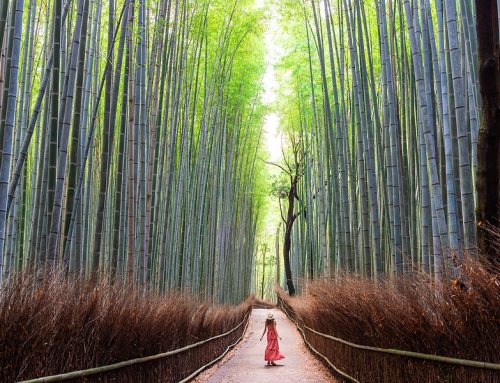
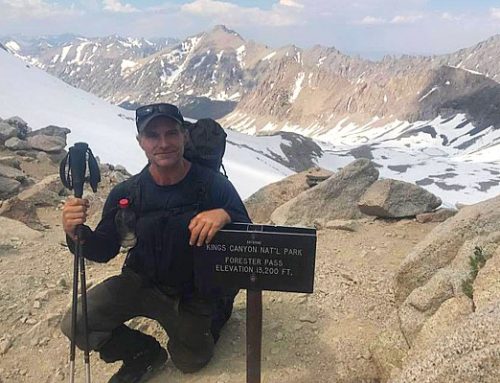
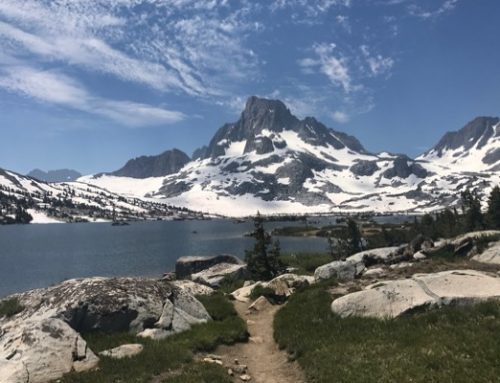
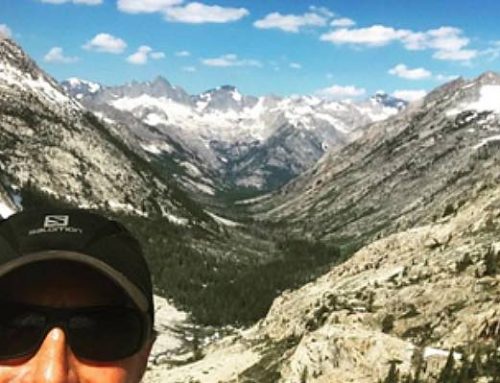
Leave A Comment